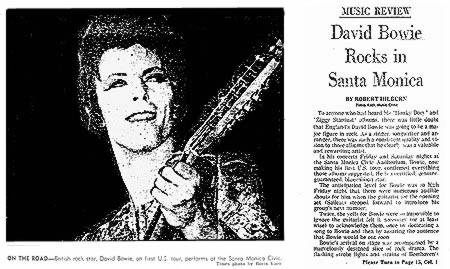 Companion
Companion![]() The
The  Companion
Companion
Home ¦ Index ¦ FAQ ¦ Encyclopaedia ¦ Timeline ¦ Songs ¦ Gallery ¦ E-mail

ON THE ROAD - British rock star, David Bowie, on first US
tour, performs at the Santa Monica Civic.
Times photo by Boris Yaro.
By Robert Hilburn - Los Angeles Times (23 October 1972)
"Pop music thrives on the discovery of exciting and original new artists--stepping into a club or arena and being so swept away by the artist's imagination and charisma that you feel a page in pop history is being turned. My own list of memorable first encounters includes David Bowie at the Santa Monica Civic Auditorium ... Bob Marley at the Roxy ... U2 at the Country Club ... Prince at Flippers ... Ani DiFranco at the Mayan ... N.W.A at the Celebrity Theatre." - Robert Hilburn LA Times 2002
To anyone who had heard his "Hunky Dory" and "Ziggy Stardust" albums, there was little doubt that England's David Bowie was going to be a major figure in rock. As a singer, songwriter and arranger, there was such a consistent quality and vision to those albums that he clearly was a valuable and rewarding artist.
In his concerts Friday and Saturday nights at the Santa Monica Civic Auditorium, Bowie, now making his first US tour, confirmed everything those albums suggested. He is a certified, genuine, guaranteed, blue-ribbon star.
The anticipation level for Bowie was so high Friday night that there were numerous audible shouts for him when the guitarist for the opening act (Sailcat) stepped forward to introduce his group's next number.
Twice, the yells for Bowie were so impossible to ignore, the guitarist felt it necessary (or at least wise) to acknowledge them, once by dedicating a song to Bowie and then by assuring the audience that Bowie would be out soon.
Bowie's arrival on stage was accompanied by a marvelously designed slice of rock drama. The flashing strobe lights and strains of Beethoven's "Ode to Joy" combined perfectly with the band's futuristic space suits and Bowie's own bisexual image to provide an aura of "Clockwork Orange", not so much in the sense of violence as in an incredible sense of "nowness" and the wave of the future. Future shock had arrived.
Bowie, his face covered by a modest layer of white makeup and his carrot-tinted hair so colourful that it looked almost aflame, opened with "Hang Onto Yourself", a song from "Ziggy Stardust" that is a perfect invitation to a rock concert: "So come on, come on, we've really got a good thing going..."
Two things were immediately apparent. First, Bowie, with a background in mime, has enormous stage control and is able to accomplish more with the mere movement of his eyes than most performers in rock can do with a whole series of exaggerated movements. His body is so disciplined that Bowie can create the tension of a wild animal, a tiger or panther, as he prowls the stage, controlling the pace and direction of the show as he moves.
Band in Control
Second, the band - Mick Ronson on lead guitar, Trevor Bolder on bass and Mick Woodmansey on drums - is a tight and controlled group, one that is able to work as a unit rather than, as with so many bands, a collection of individuals. It can provide all the vigor that a rocker such as "Suffragette City" requires, yet also offer the fluidity that a song such as "Changes" demands.Bowie's arrival and opening number are so powerful in their impact that they - particularly when coupled with the flamboyance of the photos that preceded Bowie here in ads and elsewhere - lead the audience to believe there is going to be more in the area of theatrical dynamics than Bowie actually delivers, causing the audience to readjust its expectations....
Though the Friday audience seemed to accept Bowie's movement from rock to soft to rock again, portions of the Saturday audience - seemingly less culty - exhibited an occasional impatience with the soft numbers. There was some noticeable audience conversation during "My Death" for instance, and some shouts of "rock n roll" and other "get it on" urgings after that song.
It isn't, one senses, that Bowie couldn't put together an evening built solely around powerhouse rock rather than divide his time between soft and rock numbers. But that doesn't seem to be his style, it doesn't seem to be his goal. He wants to establish his own unique musical and emotional identity. He doesn't want to be simply a rock n roll star.
Judy Garland Role
There have been some who have suggested Bowie has the talent, originality and charisma to become some sort of Elvis Presley of the 1970's, but his more likely target/model if he had the power to choose a role, would be a sort of male Judy Garland of the 1970's.Indeed, his most electric moment, aside from the opening both nights, was when he established the same delicate, separate sense of communication with the audience that reminds you of a Garland.
In his most intense and perhaps open portrayal of the evening, he assured the audience (in his "Rock n Roll Suicide" encore) "You're not alone...gimme your hands." And the hands reached up for him. Bowie, there's no doubt about it, is a major star, both in a commercial and most importantly, an artistic sense.
---This page last modified: 12 Dec 2018---
